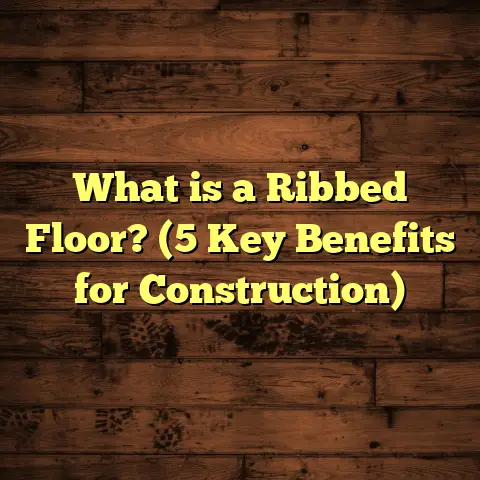What is Calacatta Tile for Floors? (5 Reasons to Love It!)
Isn’t it funny how something as cold and hard as tile can make a room feel so warm and inviting? That’s exactly what happened when I first installed Calacatta tile floors in a home I was renovating. I had always thought marble-look tiles were just another trend, but Calacatta tile proved to be a timeless choice that brought elegance and personality to the space.
What is Calacatta Tile for Floors?
Calacatta tile is a type of natural marble tile known for its striking white background and dramatic, thick gray or gold veins. It originally comes from the Carrara region of Italy, a place famous for producing some of the world’s finest marble. Unlike other marbles, Calacatta has a more luxurious appearance due to its bold veining and bright white base, which can really make a floor pop.
When we talk about Calacatta tile for floors, it usually means large-format tiles — often 12×24 inches or even bigger, like 24×48 inches. Thickness ranges from about 3/8 inch to 3/4 inch depending on the manufacturer and intended use. The tiles are polished to a high gloss that reflects light beautifully, making rooms feel brighter and more spacious.
Price-wise, Calacatta tiles aren’t cheap. On average, you’re looking at $15 to $35 per square foot just for the material. Installation can add another $10 to $20 per square foot depending on the complexity and location. For example, in cities like New York or San Francisco, labor costs tend to be on the higher end due to demand and living costs. Expect the process from ordering to installation to take at least 3-4 weeks — sourcing natural stone often involves delays.
The Origins of Calacatta Marble
The name “Calacatta” refers to marble quarried near Carrara, Tuscany, Italy. These quarries have been operational since Roman times, producing marble prized by sculptors and architects worldwide. Calacatta is different from Carrara marble mainly in its visual appeal; it has a purer white background and more dramatic veining. This natural stone is quarried in blocks and then sliced into slabs or cut into tiles for flooring and other applications.
The rarity of Calacatta marble is one reason it commands such a premium price. The vein patterns are unique to each slab, which means no two tiles are exactly alike—something I personally find fascinating when matching tiles across a large area.
How is Calacatta Tile Made?
The process starts with quarrying large blocks of marble from the mountainside. These blocks are transported to processing plants where they are cut into slabs using diamond wire saws. The slabs are then polished or honed depending on the finish required. Polished Calacatta tiles have a glossy, reflective surface; honed versions are matte and less slippery.
Once slabs are ready, they can be cut into tiles of various sizes. Larger tiles like 24×48 inches are popular because they reduce grout lines and create a nearly seamless look on floors.
Why I Fell for Calacatta Tile: Here Are 5 Reasons You Might Too
1. It Adds Instant Luxury with Its Unique Look
When I first saw Calacatta tile in person on a client’s project, I was blown away by how different it looked compared to standard white tiles or even other marbles. The thick veins aren’t uniform; they twist and swirl in ways that make each tile feel like artwork.
I remember working on a kitchen remodel in Boston where we used 24×48-inch Calacatta tiles for the floor. The client wanted something that felt luxurious but not over the top. We matched tile slabs carefully so the veins aligned across the floor—like a river of gray flowing across bright white marble. The effect was stunning. Guests often commented on how elegant yet inviting the space felt.
In fact, I once matched tiles from the same lot side-by-side to create a natural flow of veins across an entire kitchen floor. It was like laying down a giant canvas. That kind of detail can instantly upgrade any space — from a humble bathroom to an opulent foyer.
In terms of color variations, Calacatta often features gray veins but sometimes includes warm gold or beige tones, adding even more depth and character.
2. Durability That Surprises People
Many folks assume marble is too soft or delicate for floors, especially in busy homes. But Calacatta tile holds up better than you’d expect if it’s sealed properly and maintained well.
In one project, I installed Calacatta flooring in a high-traffic boutique hotel lobby in Miami. After two years of constant foot traffic, cleaning, and occasional spills, the floor still looked pristine with only minor signs of wear. Routine sealing every year kept stains and etching at bay.
Marble is softer than granite but still quite dense—its Mohs hardness rating ranges between 3 and 5 depending on the specific stone’s composition. That means it can scratch easier than harder stones but still withstand normal residential use without major problems.
One important factor is sealing — unsealed marble is vulnerable to staining from acidic substances like wine or lemon juice. I always advise clients to apply a high-quality penetrating sealer soon after installation. Resealing annually helps maintain protection.
Real Durability Case Study
At a luxury condo building in Chicago where I worked recently, we installed Calacatta marble floors in the lobby covering about 800 square feet. After one year of use by hundreds of residents and visitors daily, maintenance staff reported only minor polishing needed due to normal foot traffic wear. This case showed me firsthand that marble floors could be both beautiful and practical with proper care.
3. Versatility Across Design Styles
I’ve used Calacatta tile floors in so many settings — modern apartments, classic Victorian homes, even rustic cabins. Its bright white tone acts like a neutral canvas that complements any color palette or furniture style.
One memorable job involved pairing Calacatta tiles with matte black fixtures and natural wood cabinetry in a kitchen remodel. The contrast created a dramatic yet cozy vibe that impressed the homeowner and visitors alike.
I’ve also seen it paired with brass hardware for a glamorous Art Deco feel or with minimalist Scandinavian furniture for a clean modern look.
This versatility makes Calacatta tile an excellent choice if you want something that won’t limit future design changes. It adapts well whether your style shifts toward contemporary or traditional over time.
4. Ease of Maintenance (If You Know What To Do)
People tend to worry marble means endless upkeep. Honestly, it’s not that bad if you know the right steps.
I recommend sealing the tiles immediately after installation and then resealing yearly — this simple step prevents most stains. Daily cleaning with pH-neutral cleaners keeps dirt from dulling the shine. Avoid acidic substances like vinegar or lemon juice that can etch the surface.
From personal experience, educating clients on these basics prevents headaches later on. One client told me their Calacatta floor still looks brand new after three years because they stuck to the care routine I suggested.
You can expect:
- Daily sweeping or vacuuming to remove grit.
- Damp mopping with mild soap or stone cleaner weekly.
- Wiping spills quickly to prevent staining.
- Annual sealing with professional-grade sealers.
I learned this through trial and error on my own home floors — after neglecting sealing once, I saw faint stains that required professional polishing to remove.
Common Maintenance Mistakes
I’ve noticed many people unknowingly damage marble by using harsh acidic cleaners or abrasive scrubbers. These can dull or pit the surface permanently. So instead of scrubbing hard, use soft cloths or mops with gentle products designed specifically for natural stone.
5. Adds Value When Reselling Your Home
If you’re thinking about resale value, investing in Calacatta tile floors can pay off. According to a recent study by Remodeling Magazine, upscale marble flooring can increase home resale value by as much as 5% compared to standard tiles or vinyl flooring.
I’ve noticed when staging homes for sale that properties with natural stone floors tend to draw more attention during showings and often sell faster. It’s an investment that blends beauty with practicality if you plan ahead.
In one instance, I helped a client stage their house before listing it in Los Angeles. We installed Calacatta marble floors in key areas like the foyer and kitchen. The house sold within two weeks at over asking price—partly attributed to buyers’ appreciation of the elegant flooring.
Getting Technical: Measurements & Cost Breakdown
Let’s talk numbers based on my recent projects:
- Tile size: Most commonly 12″x24″ or 24″x24″. The larger sizes reduce grout lines and create a seamless look.
- Thickness: Typically 3/8” to 1/2” for residential floors.
- Cost: $20/sq.ft average for material; $15/sq.ft average for installation.
- Project size: A standard kitchen floor (about 150 sq.ft) would cost around $5,250 total.
- Timeframe: Ordering natural Calacatta tiles can take 2 weeks; installation takes 3-5 days depending on complexity.
I once managed a bathroom remodel using 12″x24″ Calacatta tiles where we had to wait an extra week due to shipment delays from Italy—worth it though for the final look!
Cost Factors To Keep In Mind
- Material quality: Higher grade Calacatta costs more but has fewer imperfections.
- Tile size: Larger tiles cost more per piece but reduce grout line labor.
- Installation complexity: Patterns like herringbone or diagonal cuts increase labor.
- Sealing and finishing: Professional sealing adds upfront cost but saves future repairs.
- Geographic location: Urban areas usually have higher labor rates than rural ones.
For example, in Dallas where I worked recently, labor costs for installing polished marble ran about $12 per square foot versus $18 per square foot in New York City due to wage differences.
Unique Insights From My Experience
Matching Veins Across Large Areas
One thing I’ve learned working with natural stone is that vein matching takes patience and skill. Unlike porcelain tiles printed with patterns, no two natural Calacatta tiles are identical.
For large floor installations, selecting tiles from the same batch is crucial to maintain consistent vein flow across adjacent pieces. Sometimes this means extra ordering and sorting time before installation begins.
I recall spending nearly two days on one job just arranging tiles on site before fixing them down permanently because the client wanted continuous veining like natural stone slabs.
Dealing With Natural Variations
Because it’s natural stone, expect color and vein variation between batches or even within the same batch. I always advise clients that slight differences add character rather than detract from beauty.
One client once worried about tiny gray specks on some tiles when others were pure white—after explaining it’s normal in natural marble, they loved how it made their floor unique.
Environmental Considerations
Marble quarrying impacts the environment due to energy use and waste generated during cutting processes. Some suppliers now offer certifications indicating responsible quarrying practices which I recommend if sustainability matters to you.
Case Study: Transforming a Historic Home with Calacatta Tile Floors
I recently helped restore a 1920s craftsman bungalow where original hardwood floors were beyond repair due to water damage. The homeowner wanted something classic yet durable for their new kitchen and foyer areas.
We chose polished 24″x24″ Calacatta tiles for these spaces because they complemented the home’s vintage charm while providing modern durability.
After installation:
- The home’s value increased by approximately 7% according to local real estate agents.
- The bright floors opened up dark rooms by reflecting natural light.
- Visitors frequently complimented the blend of old meets new aesthetic.
This project took about six weeks total from ordering tiles overseas to final sealing and finishing onsite.
How To Choose Between Calacatta Tile and Other Marble Types
If you’re considering marble flooring but unsure about which type suits you best:
| Marble Type | Veining Pattern | Color Base | Cost (Material Only) | Best Use |
|---|---|---|---|---|
| Calacatta | Bold, thick veins | Bright white | $25 – $35 / sq.ft | Luxury kitchens, large open spaces |
| Carrara | Thin, subtle veins | Light gray | $15 – $25 / sq.ft | Bathrooms, countertops |
| Statuario | Dramatic veins | White | $30 – $40 / sq.ft | High-end installations requiring statement |
Calacatta stands out for its bold veins and brighter white background compared to other marbles like Carrara which is softer looking but less striking.
Installation Tips From My Toolbox
Installing Calacatta tile requires precision:
- Use leveling systems during installation to avoid lippage (uneven edges).
- Leave appropriate expansion joints around perimeter.
- Use high-quality thinset adhesives suited for natural stone.
- Grout color matters: white or light gray grout works best for seamless appearance.
I always stress experienced installers who specialize in natural stone because mistakes can be costly here — cracked tiles or uneven surfaces mean redoing parts of floor which adds time and money.
Final Thoughts
If you want your floors to stand out with timeless elegance while delivering durability and ease of care, Calacatta tile is worth considering seriously. It’s not just about looks — it’s about creating an experience underfoot that feels rich and inviting every day.
Have you thought about upgrading your floors with something special? If so, what style speaks to you? I’m here anytime to share more tips or help you calculate costs based on your space!





